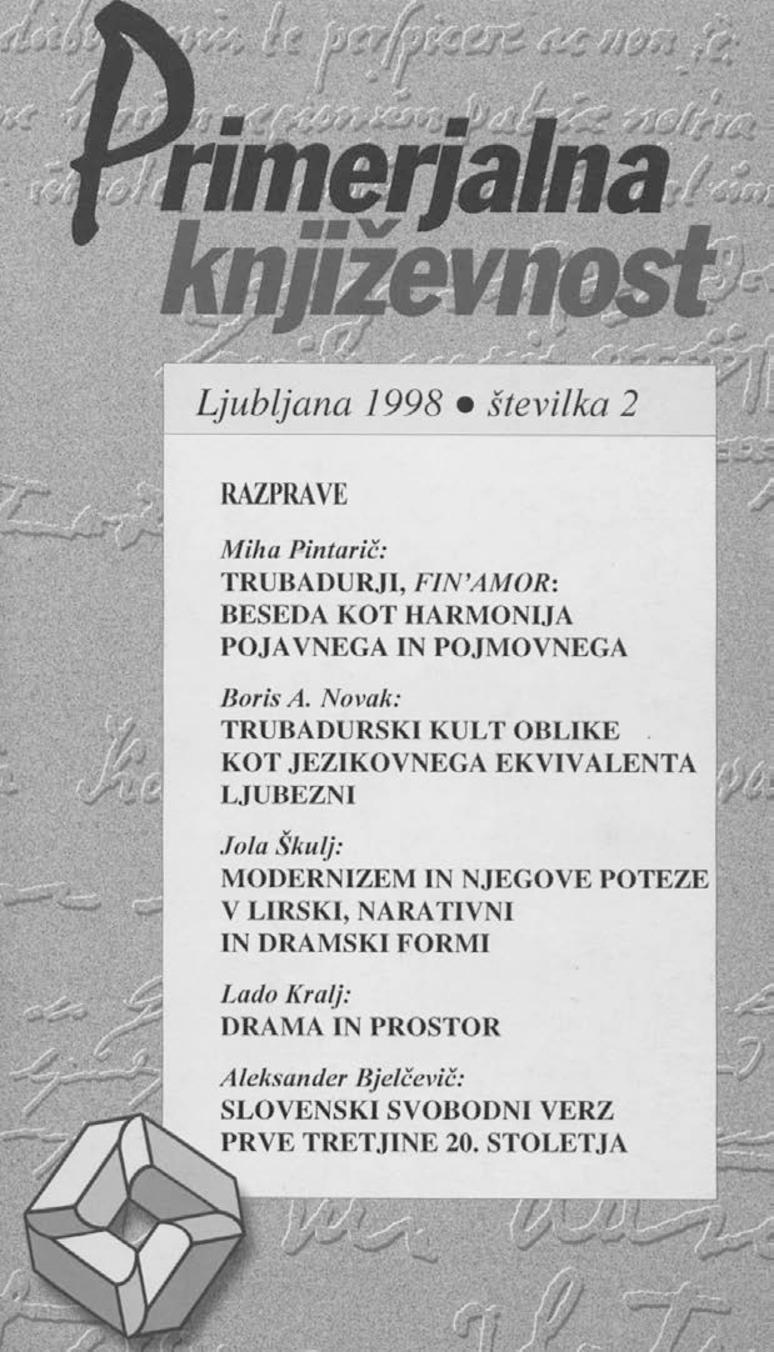Slovene Free Verse in the First Third of the 20th Century
Keywords:
literary theory, versification, Slovene verse, free verse, Slovene literature, Slovene poetry, Oton Župančič, Josip Murn, Joža Lovrenčič, Srečko Kosovel, Edvard KocbekAbstract
The cult of the new, which was initiated in European culture at the turn of the century, is also seen in the invention of new verse forms. The predominant forms in Slovene poetry of the 19th century were regular accentual-syllabic and strict-stress meters (the first position in the verse is weak, while the intervals between icti are mono- or disyllabic; strict-stress meters account for about a fifth of the output). Irregular accentual-syllabic meters also occurred occasionally (Levstik, Gregorčič): classical lines of varying length, but in the same meter occur in unpredictable succession (e.g. 5-, 6-, 8-, 11-syllabic amphibrachs). Irregular strict-stress meter, the irregular intertwining of one- to four ictic lines was, however, very rare; this occurred only in Levstik’s and Stritar’s work. In the Slovene moderna the number of modifications of classical forms increased: a) new kinds of irregular iamb and amphibrach (a mixture of classical and extra-long lines), the contrasting of short and long lines, the breaking of classical measures into various verses (e.g. “On the Market”, “Na trgu”, by Kette); b) irregular accentual-syllabic verse, where iambic and trochaic, and amphibrach and dactylic lines are intertwined (A. Vodnik, F. Albrecht); c) the experiment with irregular strict-stress meter was renewed and given new forms: lines of up to six icti, the first position in the verse is strong (Župančič). Only on rare occasions are there experiments with free verse in the moderna. Such free verse sometimes does not rhyme and is either syntagmatic (borders of verse-lines coincide with borders of syntagmas/phrases, one sentence running over a few verses: “Of the Holy Spirit”, “O svetem duhu”, by Župančič), or sentential (borders of verse-lines coincide with borders of sentences: “Spring Romance”, “Pomladanska romanca”, by Murn). Poems which are not divided into stanzas, and poems which have stanzas of various length are predominant. The continuous development of free verse begins between 1913 and 1917 with Joža Lovrenčič, who used sentential free verse. He wrote poly-type verses (accentual-syllabics and free verse within the same poem), which later also occurs in Jarc’s plays. In the twenties, sentential free verse was predominant, with typical parallelism as the rhythmic factor in Seliškar’s work. Syntagmatic free verse is rarely in use, but we can find it in Kosovel’s work. Anti-syntactic free verse (borders of verse-lines are within syntagmas, and the sentence borders thus within verses; enjambment is the foundation of such verse) occurs in the thirties in Kocbek’s writings.References
BJELČEVIČ, Aleksander 1997/98: »Svobodni verz 1 in 2.« Jezik in slovstvo, 43, št. 6 in 8.
ČERVENKA, Miroslav 1974: »O tematycznym następstwie.« Tekst i język: problemy semantyczne. Ur. M. R. Mayenowa. Vroclav, Varšava … PAN/IBL.
PETRÈ, Fran 1990: Tradicija in inovacija. Ljubljana: Slovenska matica.
URBAŃSKA, Dorota 1995: Wiersz wolny. Varšava: IBL.
STABEJ, Marko 1994: Slovenski pesniški jezik prve polovice 20. stoletja. Magistrska naloga. Ljubljana: Filozofska fakulteta (Oddelek za slovanske jezike in književnosti).
VREČKO, Janez 1986: Srečko Kosovel, slovenska zgodovinska avantgarda in zenitizem. Maribor: Založba Obzorja.
ZADRAVEC, Franc 1972: Zgodovina slovenskega slovstva 6. Ekspresionizem in socialni realizem. Maribor: Založba Obzorja.


